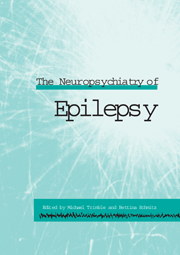Book contents
- Frontmatter
- Contents
- List of contributors
- Part I Background
- Part II Clinical aspects
- Part III Cognitive aspects
- Part IV Nonepileptic attacks
- Part V Treatment complications
- Part VI Treatment
- 20 On the use of psychotropic drugs in patients with seizure disorder
- 21 The role of psychotherapy in the treatment of epilepsies
- 22 Choosing measures to assess quality of life (QOL) in epilepsy
- Index
22 - Choosing measures to assess quality of life (QOL) in epilepsy
Published online by Cambridge University Press: 05 October 2010
- Frontmatter
- Contents
- List of contributors
- Part I Background
- Part II Clinical aspects
- Part III Cognitive aspects
- Part IV Nonepileptic attacks
- Part V Treatment complications
- Part VI Treatment
- 20 On the use of psychotropic drugs in patients with seizure disorder
- 21 The role of psychotherapy in the treatment of epilepsies
- 22 Choosing measures to assess quality of life (QOL) in epilepsy
- Index
Summary
Why assess quality of life?
Whilst quality of life (QOL) measures have been developed for a number of reasons (Fitzpatrick et al., 1992), two basic aspects of health care underlie most of the questions that QOL appraisals set out to answer: outcome of treatment and cost. With increasingly sophisticated life-saving and life-prolonging medical interventions, and a range of options between alternative treatments, quality of life has emerged as an important outcome. Also, it is argued that no country in the world can afford to do all that it is technically possible to do to improve the health of its citizens and so the need has arisen for some system of setting priorities. Quality of life and other outcome data are informing health economic decisions and debate about the allocation of scarce resources. The field of QOL research is thriving, and much progress has been made in the last 10 years.
Types of QOL measure
There is no ‘gold standard’ for measuring QOL and the range of instruments available, or still undergoing development, is remarkable in terms of both quantity and heterogeneity. The range of categories of QOL/health status measures has been comprehensively reviewed elsewhere (Brooks, 1995). In brief, generic instruments cover a broad range of QOL domains in a single instrument. Their chief advantage is in facilitating comparisons among different disease groups. Disease-specific instruments reduce patient burden by including only relevant items for a particular illness but their main disadvantage is the lack of comparability of results with those from other disease groups.
- Type
- Chapter
- Information
- The Neuropsychiatry of Epilepsy , pp. 323 - 342Publisher: Cambridge University PressPrint publication year: 2002

